马斯克到底想要什么
马斯克是如何演变的:他如何从一个关注气候变化、想去火星的奥巴马时代传统自由主义者,变成一个右翼阴谋论传播者,一个积极为德国极右助选,并瓦解美国联邦政府的人?
 JinseFinance
JinseFinance
Written by: Black Mario
In the blockchain world, the mainstream represented by Bitcoin and Ethereum networks Blockchain laid the early foundation for this field and made decentralization, peer-to-peer, openness, transparency, and irreversibility the inherent ideologies of this field. In fact, being too transparent is becoming a major obstacle to the large-scale adoption of blockchain. We see that more than 90% of mainstream blockchain systems are characterized by openness and transparency. Any on-chain transactions will be disclosed in a distributed ledger. , this also means that the lack of native privacy prevents the blockchain from providing support for many scenarios.
For example, in some SLG and MMORPG games such as poker games, Monopoly, and trading card games, unpredictable randomness and privacy are necessary, but the inherent transparency of the blockchain leads to Some game mechanics tend to be predictable, which means that it would be unfair for a strategy game to be played entirely on-chain. For another example, in some traditional financial businesses, the confidentiality of data and transactions is extremely critical and important, but the existing blockchain can only provide reasonable support for DeFi.
Although the blockchain field has always been exploring native privacy, we have seen that the early Zcash, Monero and Dash did not support anonymous systems with programmable expansion, but we have seen that It itself has considerable limitations and has not been further adopted. Some representatives of emerging Turing-complete privacy ecosystems, such as Secret Network and Oasis Protocol, usually sacrifice performance and lack certain scalability.
On the other hand, Layer2 also has high hopes for privacy. For example, privacy is established based on ZKP on zk Rollup Layer2. However, Layer2 itself does not have sovereignty, which may mean that it suffers from many aspects of throughput and availability. Limited by Layer 1, and has the risk of off-chain data leakage. So we see that in past blockchain privacy cases, privacy protection, scalability and decentralization seem to be becoming a new impossible triangle. The emergence of Partisia Blockchain is breaking this dilemma faced by the blockchain field.
Partisia Blockchain is a Layer1 network characterized by high burstiness, privacy, high interoperability, and scalability. By introducing MPC technology solutions into the blockchain system, based on zero-knowledge proof (ZK) technology and multi-party computation (MPC), we jointly ensure data privacy without affecting network integrity and security. On this basis, Partisia Blockchain has launched a new set of sharding solutions, provable fast-channel consensus and Oracle service framework, which will not only expand the blockchain function to interact with external data sources, but also allow Partisia Blockchain to upgrade A versatile, private, efficient and connected digital economy solution.
Based on its own characteristics, Partisia Blockchain’s “MPC-as-a-Service” system has currently penetrated into various Layer1 function scenario applications, including auctions (DEXs), surveys, voting, and artificial intelligence , machine learning, supply chain, fund management, data sharing and other fields, this system is also an enterprise-level blockchain Layer 1 ecosystem currently recognized by the industry and expected to be adopted on a large scale.
This article will introduce and analyze Partisia Blockchain from multiple aspects to further enhance readers’ understanding of Partisia Blockchain.
Partisia is an enterprise-level layer with privacy, interoperability and high burstability The Layer1 system combines blockchain and zero-knowledge computing (including MPC, zero-knowledge proof ZKP, etc.) in a collaborative manner, and through the sharding scheme, Bring Your Own Coin (BYOC) function and Oracle service framework, Build a more secure digital infrastructure. Partisia hopes to build a new solution that is suitable for any type of enterprise-level blockchain solution, including supply chain companies, SaaS (software as a service) providers, financial technology applications and even social media, etc.
1. Privacy
Based on zero-knowledge such as MPC+ZKP Solution to establish privacy
The privacy features of the Partisia system come from ZK and MPC (multi-party computation), which together ensure the data privacy of the Partisia network without affecting network integrity and security. This dual approach enables complex calculations to be performed on encrypted data, thereby improving data privacy by default, while facilitating seamless interactions between different blockchain networks and traditional databases, expanding the space of potential applications of the technology.
MPC is a collaborative computing framework based on cryptography. Broadly understood, multiple parties each have private input and work together to complete a computing task. While successfully completing the task, they can ensure that each party has their own private input during the entire process. The private input will not be leaked, and usually this process occurs off-chain.
Let’s take wallet creation as an example. When a wallet is jointly created by multiple parties, the private key generated by the wallet will be divided into several fragments in some way and distributed to multiple parties. Based on MPC The own threshold signature algorithm will be able to generate a legal signature without presenting the complete private key. We see that MPC does not go through smart contracts after generating signatures based on algorithms off-chain, so MPC itself does not need to adapt to the contract and chain systems. At the same time, what is uploaded to the chain is the result of the signature. No one can find out that the signature is made by Which parties produced it.
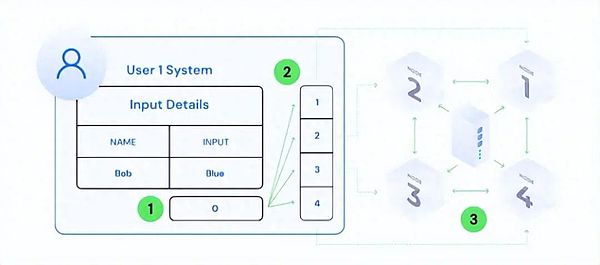
With At the same time, the strategy of the MPC signature mechanism is off-chain, which avoids the risk of the contract being attacked by hackers, and the design strategy can be more flexible (most processes are off-chain). Users can formulate their own fragmentation management strategies according to the scenario. In addition, MPC can easily change the number of Key Shares while keeping the receiving address unchanged (MPC can continuously refresh it internally) to further increase the security threshold and reduce security risks.
The threshold signature based on MPC directly strips the key from the system at the physical level. For example, the signature generation process, including the fragment generation process, can be regarded as a secure multi-party computation, because during the execution of the protocol, All intermediate data generated and exchanged will not directly or indirectly cause the leakage of fragmented plaintext. This means that throughout the information management life cycle, real verification information never appears.
Partisia implements an innovative key protection mechanism through multi-party computation (MPC) technology. By decentralizing shared key information among different servers, there is no need to expose the complete key on a single device when performing operations such as digital signatures. Based on this, Partisia can realize secret sharing and privacy calculation of smart contract status, ensuring that sensitive information can only be known by the execution of the contract. Even in scenarios where sensitive information needs to be handled, such as auctions, the privacy of each participant is guaranteed.
Introducing MPC nodes into the chain
The core security guarantee of multi-party computation (MPC) technology comes from its distributed computing method, which requires participation Individual servers for computing must be independent and not controlled by a single entity. In past MPC solutions, the provision of computing resources usually came from off-chain, but one problem is that off-chain computing may have certain trust and security challenges, and it also requires independent entities willing to set up and maintain these servers to provide long-term Computing services. Partisia has introduced zk computing nodes in the network. Based on the blockchain network consensus drive, zk nodes with computing capabilities will provide services for the zero-knowledge computing required in the network in a spontaneous manner and obtain rewards from the network. This new integration not only simplifies the deployment and management process of MPC, but also enhances the security and transparency of the entire system by leveraging the characteristics of blockchain. Based on the blockchain, MPC can interconnect and share trust and data. Based on this, Partisia has established a node reputation system and punishes misbehaving nodes through smart contracts, thus maintaining the health and safety of the network.
At the same time, Partisia uses the ordered broadcast mechanism of the blockchain to solve the coordination problem in the distributed system, improves the reliability and efficiency of the system, and also makes the execution of MPC services more flexible and reliable.
Zero-knowledge layer
From the perspective of the encryption industry, although privacy solutions can match many scenarios, they are also compliant and auditable. . Zero-knowledge proof is an important solution to ensure compliance. Through the use of ZK zero-knowledge proof, users are given complete privacy rights within the maximum permitted range, enabling all types of DApps developed on the Partisia Blockchain to comply with data protection regulations such as GDPR. , fully responds to requirements such as the “right to privacy” (data remains private at all stages, including at rest, transmission and processing), and the “right to be forgotten” (encrypted data used in zero-knowledge computing is deleted after use).
Partisia is also a high burst blockchain system, which can achieve fast transactions within 1 second and has short-term Its high burstability and ability to process a large number of transactions concurrently make it very suitable for enterprise-level applications and services.
Consensus Mechanism
Partisia has built a unique consensus mechanism system (Poseidon), which is a provable fast-track consensus that combines proof of equity (PoS) and MPC to verify on-chain transactions and generate new blocks, tailored specifically to reduce traditional Proof of Work (PoW) energy consumption, ensuring high throughput and low latency in transaction processing.
In most blockchain networks, a transaction usually needs to be packaged and broadcast to the entire network before it can be added to the block, which may face higher transaction costs when the network is congested. Latency and processing time significantly slow down the speed at which the network processes transactions.
In Partisia’s provable fast-track consensus system, transactions can be added to the distributed ledger through block creation and executed immediately upon completion of signatures, thereby establishing a P2P network that propagates and aggregates signatures consensus. When a node obtains the signatures of 2/3 or more nodes, it will establish a Proof-of-Justification (PoJ) and continue to evaluate the next block to achieve cyclic operation. The speed of this process is similar to that in the P2P network. information transfer speed is just as fast. The Poseidon consensus system is the most important source of efficient network transaction processing, and in addition to the Poseidon consensus, sharding brings extremely high explosiveness to Partisia.
Complete sharding model
Under the guarantee of the consensus mechanism, Partisia Blockchain also uses advanced sharding technology to achieve network expansion, dividing larger blocks into The chain is divided into smaller, manageable blocks that can process parallel transactions. Partisia Blockchain is sharded by treating the Baker nodes (functioning in consensus mechanism and governance) in all shards as the real layer 1. Each shard creates verifiable blocks according to the consensus model proposed by Poseidon without affecting the consensus model. The operation increases the processing capacity of concurrent transactions by 3 times when linearly scaling the number of shards. In this way, the capacity of the Partisia Blockchain can be scaled to accommodate any number of transactions per second, with a shard capacity of approximately 1,000 TPS requiring only one transaction to complete.
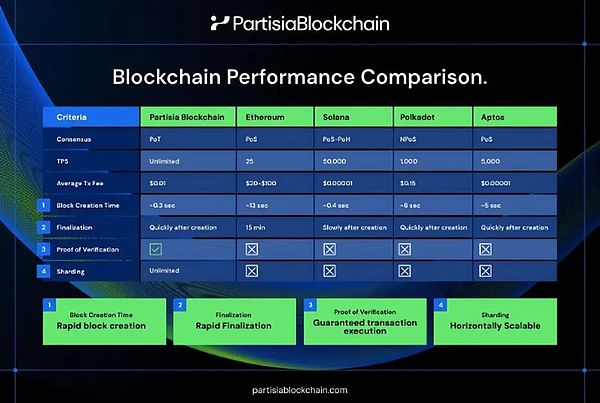
And Based on sharding capabilities + innovative consensus algorithms, Partisia Blockchain is able to handle a large number of transactions, making it very suitable for enterprise-level applications and services.
Oracle service framework
Poseidon has built an Oracle service framework. It is composed of different Oracle interoperable nodes and is based on network MPC, ZKP and other technical solutions. It can not only extend the blockchain function to support interaction with external data sources, but also upgrade the Partisia Blockchain to a multi-functional, private, and Efficient and connected digital economy solutions. Compared with interoperability solutions such as LayerZero, CCIP, and Wormhole, Poseidon has outstanding advantages in decentralization, security, and easy expansion.
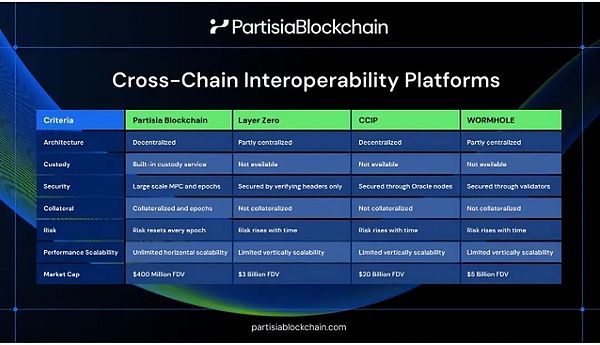
Based on Oracle, Poseidon launch native staking asset bridge as well as Hermes and Bring Your Own Coin (BYOC) functionality.
Hermes cross-chain bridge
Hermes cross-chain bridge is designed to improve the security of on-chain transactions. With the support of the Oracle service framework, it supports two The pledged assets are transferred on an independent blockchain network at a ratio of 1:1, and a variety of encryption tools and basic economic principles are used to efficiently and securely display and process the status of two independent blockchains. Its technical path includes:
(1) Double accounting: ensure that information is persisted on two blockchains, and establish space permissions that all users and node operators can easily access; deposits and withdrawals are Managed upon expiration by a set of independently selected Oracle nodes.
(2) Pledge bridging: The tokens represented by the small Oracle constituent nodes act as collateral, and any MPC asset holder can pledge to maintain balance in the event of fraud.
(3) Small Oracle security selection: The MPC signature scheme run by the large Oracle (that is, all available Baker nodes) ensures that the small Oracle selection matches the security of the consensus model; the large Oracle node is also responsible for Member identity verification is delegated to the partner chain, thereby establishing a double secure ledger.
Bring Your Own Coin (BYOC) feature
BYOC is a feature that allows customers to pay using their preferred payment method (such as ETH, USDC, etc.) The functionality of fees secures the bridge through advanced massive multi-party computation (MPC) key generation, collateralized by node operators with no accumulated risk. First, users with an ETH wallet create a user account on the Partisia blockchain, which will hold the BYOC tokens the bridge creates to create any BYOC twin tokens. BYOC twin tokens (which can only be managed by users through the Partisia chain) can be created simply by transferring ETH to the MPC-ETH wallet.
Once the account is established, if the user transfers ETH to the MPC-ETH wallet, Partisia Blockchain's BYOC token bridge will register the transfer, sign the transaction, create the ETH's BYOC twin token, and update the built-in A dual accounting system to show the user's ETH BYOC twin token balance on the Partisia blockchain account, and the matching ETH balance in the MPC-ETH wallet. From the user's perspective, ETH's BYOC twin tokens immediately appear in the user's Partisia blockchain account, and the user can start transacting on the Partisia blockchain. The gas fee to fund the transaction will be deducted from the user's account, and the final completion of these payments will occur automatically after approximately 30 minutes, resulting in the transfer of ETH twin tokens to the accounts of participating node operators. The BYOC function lays the foundation for introducing various assets to the chain and for introducing various businesses to the Partisia chain.
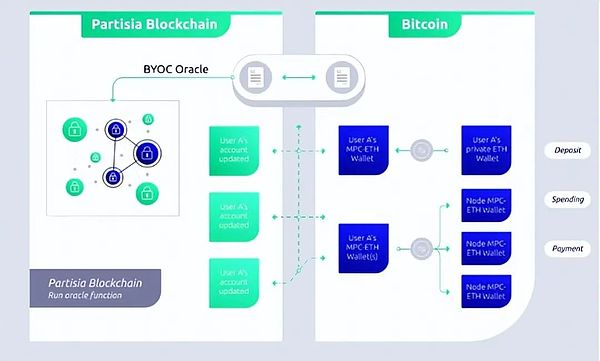
The Partisia network contains four node types, including Reader nodes, Baker nodes, ZK nodes and Oracle nodes.
Reader node: Provides a read-only perspective that anyone can access without whitelisting or staking, allowing external application services and application vendors to monitor blockchain activity to provide targeted services (similar to retrieval nodes ).
Baker Node: An integral part of the core functionality of Partisia Blockchain, handling consensus mechanisms and governance challenges (similar to PoS nodes in other networks), being compensated through shared fees for basic blockchain services, and The minimum mortgage guarantees the minimum rights and interests of actions on the chain.
ZK node: specifically used to perform zero-knowledge proof (ZK) and multi-party computing services (MPC) to ensure network privacy services. Users with computing power and hardware can provide services by becoming zk nodes and earn income from them.
Oracle node: Improve cross-chain interoperability, such as BYOC function and token bridge, to ensure cross-chain security and application functions.
MPC is an important source of privacy in the Partisia Blockchain ecosystem. It allows users to not only be protected when storing or transmitting data, but also receive multi-party guarantees when processing data. On this basis, individuals and organizations can allow private data to be used for specific purposes and retain control over the data. In computing work shared and participated by multiple parties, the potential risks caused by having to trust one party can be avoided, thereby achieving true trust. Safe and efficient.
Partisia Blockchain has built a new MPC protocol called REAL, which maximizes the use of multi-node operation matrices to promote MPC utilization while meeting the premise of efficient preprocessing. Based on this, Partisia has also launched MPC-as-a-Service (MPC as a service), which can provide MPC services for any privacy-demanding scenarios, such as finance, supply chain management, medical and health data sharing, electronic voting, and privacy data markets. And so on, it is expected to set a new standard for any type of privacy-preserving computing inside and outside the blockchain ecosystem.
The built-in privacy protection calculation in Partisia Blockchain allows smart contracts to further adapt to more scenarios . Initially, smart contracts are open and transparent, and all information and transactions transmitted and executed through smart contracts are transparent and traceable. Partisia realizes a data-driven economy based on private digital agents through universal privacy-preserving computing and smart contract automation, allowing users to independently set data information and improve bargaining power. That is, smart contracts can be selected as privacy smart contracts, or only Smart contracts that disclose information to certain accounts to serve certain private businesses. Under this model, any developer can easily utilize zero-knowledge proof (ZK) or multi-party computation (MPC) services, while also providing a complete technology stack for on-chain privacy protection.
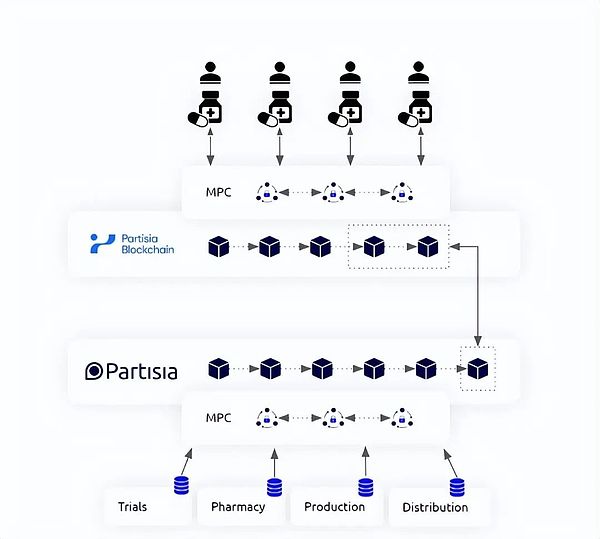
Partisia Blockchain is providing private random number services based on MPC, ZK and other technologies. By using MPC in key components, Partisia can meet the needs of games, lottery, etc. Provides a random number generation mechanism that cannot be tampered with, enhancing the security and reliability of applications.
$MPC is the token of the Partisia Blockchain ecosystem, with a total supply of one billion coins, distributed as follows:
p>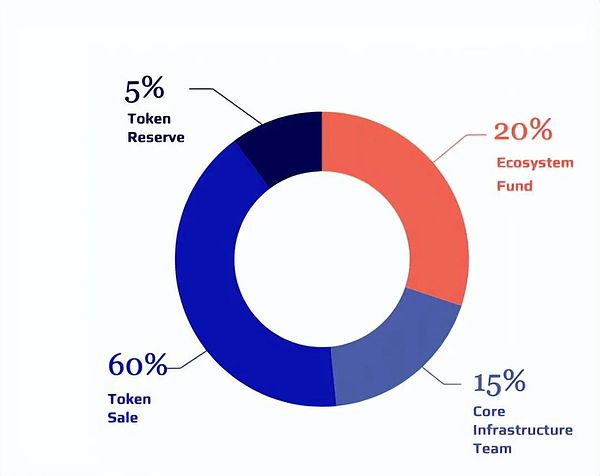
20% Ecology System Fund: Tokens allocated to the growth and development of the ecosystem.
15% Core Infrastructure Team: Tokens allocated to Partisia Blockchain founders and core development team.
60% Token Sale: Tokens for node operators and other participating agents.
5% token reserve: ecological reserve.
Token functions:
$MPC is an important asset in Partisia Blockchain. It provides private data calculation and "HERMES" cross-chain in the network. The bridge and efficient network consensus provide long-term power, and under economic factors, $MPC assets will also further reduce the risk of private data leaks, bridge hacking attacks, and price manipulation.
$MPC assets have the following functions:
Participate in governance: $MPC token holders can participate in the governance process of the network, such as Voting on important decisions such as upgrades and parameter changes.
Contribute to network security: By holding and locking $MPC tokens, participants can help secure the network, increase its security, and earn incentives.
·Collateralization: $MPC can be used as collateral when performing specific actions or participating in specific activities in the network, and profit from the potential market.
Insurance: $MPC may be used as an insurance mechanism (a reserve) within the network to help mitigate losses due to unforeseen events.
In order to encourage users to actively participate in the network, Partisia Blockchain has also launched two long-term incentives:
In order to encourage more users to pledge or become nodes, Partisia Blockchain will provide 1 100 million $MPC is used as a guide reward, which will be distributed within 10 years, and the supply will be adjusted based on the price performance of pass and tokens in the past network. The annual return rate is expected to be between 10-14%
In addition to bootstrapping rewards, Partisia Blockchain will also launch BYOC (block) rewards to reward users who use the BYOC function and pay them in the form of ETH, BNB, MATIC, USDC, USDT, etc. (depending on the user’s BYOC asset type) ), and there will be more reward options in the future.
Partisia Blockchain will be launched and market-oriented in 2021, and a test network will be launched in December 2021 , and will launch the “ZEUS” mainnet in July 2022. The team currently has nearly 40 core members, has developed more than 50+ commercial applications, and has gone through 3 rounds of private equity and 1 round of public financing. Partisia Blockchain currently has more than 250,000 social media followers and 18,000 community members on Discord and Telegram.
Based on the currently available information, we have sorted out some other detailed market developments of Partisia Blockchain.
Since its launch in 2021, Partisia Blockchain has completed 3 rounds of private placements and 1 round of public financing, raising a total of more than US$36 million. In terms of fundraising, the latest public fundraising was led by Ausvic Capital, P2P.org, Kosmos and Bitscale. Other investors include Bazar Capital, CRT Capital, Gate.io Labs and Insignius Capital, with a raised amount of US$5 million.
Partisia Blockchain Foundation is an independent public welfare organization behind Partisia Blockchain. It is headquartered in Zug, Switzerland and accepted by the Swiss authorities. supervision. The founders of Partisia and Instars jointly established the Partisia Blockchain Foundation in 2020. By relying on the founders' rich knowledge and experience reserves in cryptography, computer science and business, they jointly reached an equal agreement with the Partisia Blockchain Foundation. Currently, the fund The association has completed a total of 1,022 survey reports and 54 commercial application developments.
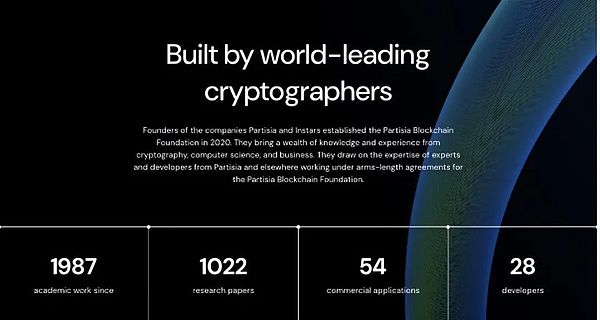
Since 2019, Partisia's PBC platform has been used for privately deployed multi-party secure computation (MPC) and blockchain services, used on commercial terms. In addition to providing basic support for Partisia Blockchain, other partners include Bosch, Provable Labs, Data for Good, Cyberian, etc.
Partisia’s public blockchain infrastructure for multi-party secure computation (MPC), Partisia Blockchain, will also be launched as a Web 3.0 public blockchain. There are currently some partners including KIN, OriginAll, and Insights Network, Humanitarian, Confidential Intelligence, International Committee of the Red Cross, etc.
In addition, the Partisia Blockchain ecosystem has successfully nurtured 12 projects, covering key areas such as wallets, applications, browsers, DeFi, NFT, infrastructure, and Launch Pad.
The airdrop of $MPC tokens
Issuance will begin on February 1, 2024, and Partisia Blockchain has set a reward pool size of 2500W $MPC tokens , providing early participation opportunities for Partisia Blockchain early users. The way to participate in early interactions is for users to migrate funds to the Partisia Blockchain wallet through the BYOC bridge and interact with the Partisia chain.
From the perspective of the encryption industry, the vast majority of blockchains themselves have not yet crossed the threshold of decentralization, scalability, and security. The impossible triangle and the lack of native privacy support also make it difficult for most public blockchains to become the underlying infrastructure to support various business scenarios. Partisia Blockchain is based on cryptography technologies such as MPC and ZKP, and through sharding, innovative consensus mechanisms and interoperability frameworks, it is breaking the inherent shackles of the blockchain and allowing decentralization, scalability, privacy and security. Find a new balance.
Because of its outstanding technical advantages, Partisia Blockchain has the potential to promote the deep integration of the Web3 market with traditional business scenarios. In fact, we see more and more Web2 companies looking to expand into the Web3 field to further expand their business scale, explore new profit models, and innovate their original business systems. For example, RWA is the most typical representative category. In this field, many traditional Web2 business giants, including Siemens, Goldman Sachs, and Hamilton Lane, are making in-depth deployments in the RWA field. The combination of traditional finance and Web3 will be a long-term trend. Likewise, It is also an important channel to introduce 800 trillion-scale traditional finance into the on-chain market. In addition to RWA, narrative directions such as AI and DePIN are also deeply integrated with the encryption market and are on the eve of the explosive singularity. Therefore, infrastructure facilities represented by Partisia Blockchain that can provide underlying technical support for this trend are in a new round. This is particularly critical in the crypto market narrative.
In practice, Partisia Blockchain’s “MPC-as-a-Service” has begun to penetrate into various Layer1 function scenario applications, including auctions (DEXs), surveys, voting, artificial intelligence, and machine learning , supply chain, fund management, data sharing and other fields, and has been able to provide business support for some well-known Web2 and Web3 partners. Through practice, it is also providing reference and accumulating experience for the future development direction of the encryption market. With the support of technology, Partisia Blockchain can more easily seek growth and increment from the Web2 market.
Through a series of practices, Partisia Blockchain is not only expected to promote the large-scale adoption of encryption technology, blockchain technology and cryptocurrency, but also provide technological innovation in the encryption field (especially MPC technology) based on its own system. adoption) provides reference.
From a valuation perspective, the market usually has extremely high valuation expectations for projects or ecosystems pioneered by technology, which also brings huge imagination to Partisia Blockchain and the upcoming $MPC. space and investment expectations.
马斯克是如何演变的:他如何从一个关注气候变化、想去火星的奥巴马时代传统自由主义者,变成一个右翼阴谋论传播者,一个积极为德国极右助选,并瓦解美国联邦政府的人?
 JinseFinance
JinseFinanceTrump personally joined the game and released the meme, dropping a nuclear bomb on the Crypto market.
 JinseFinance
JinseFinanceIn the future, BTC will absorb all long-term capital. If Microsoft replaces the "wasted" capital from stock repurchases with BTC, it will more effectively push up Microsoft's stock price. Therefore, Microsoft should adopt the BTC strategy and hoard BTC.
 JinseFinance
JinseFinanceBeing deceived by a third-party virtual currency judicial processor, let’s talk about the judicial disposal of virtual currency
 JinseFinance
JinseFinanceLove it or hate it, a crypto crackdown seems imminent, especially with the U.S. government urging Congress to accelerate its progress on crypto regulations.
 Catherine
Catherine Nulltx
NulltxOne major trend we have seen over the past 10 years is the rise of cryptocurrencies.
 Ftftx
FtftxHopefully Ethereum becomes a system more like Bitcoin.
 链向资讯
链向资讯Hope Ethereum becomes a more Bitcoin-like system
 Ftftx
FtftxThe root cause of RBI’s concern appears to be that digital assets could undermine India’s rise as a global power.
 Cointelegraph
Cointelegraph